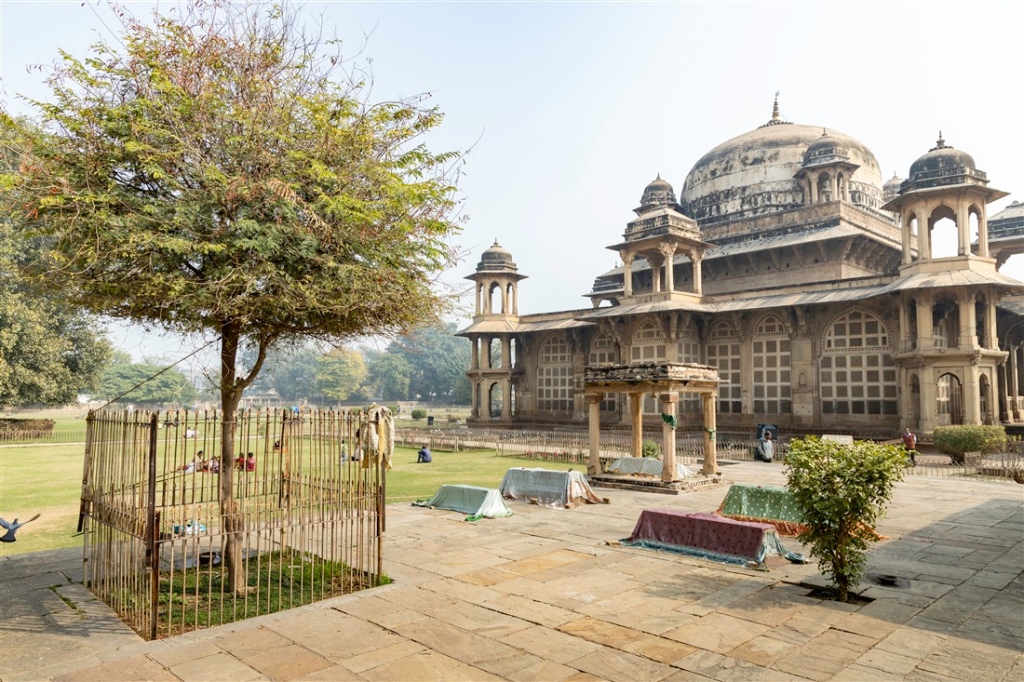
The tombs of Mohammad Ghaus and Tansen are located in a pretty park on the east side of the old city in Gwalior. If you visit Gwalior fort from the eastern approach (the pedestrian only road), the park is well under 1 km east of Gujari Mahal State Archaeological Museum at the foot of the hill.
Tomb of Muhammad Ghaus
The largest tomb in the park belongs to Muhammad Ghaus. Born in 1500 AD, Muhammad Ghaus was a Sufi saint and musician who assisted Barbur with his acquisition of Gwalior Fort in 1526.

The tomb is square with a slightly squat central dome which was once decorated with blue tiles, now sadly missing. The walls of the tomb are nearly 2m thick, supporting hexagonal corner towers crowned by smaller domes.


The highlight of this tomb from an architectural perspective has to be the carved stone lattices (jaalis) , which are on the outer wall of a lofty verandah that surrounds the inner chamber.




The intricate and elaborate patterns are simply amazing, with each example being slightly different. I’m not sure I’ve seen more impressive jaalis anywhere in India, and certainly not in such abundance.





These intricate patterns probably developed from existing primitive styles as were exhibited in the Hoysala period of architecture. The relatively hard material of marble was now replaced by the softer sandstone that was easier to carve into intricate patterns.




It’s astonishing how well this delicate stonework has survived over the last ~500 years. Unfortunately the photography doesn’t really do this building justice, I took plenty of photos but none of them really portray the experience of actually being there and seeing it for yourself.

Tomb of Tansen
Tansen’s tomb is in stark contrast to his near neighbour, and may take you some time to locate. It consists of a small rectangular pavilion with pillars surrounding the tomb itself.

Tansen was born sometime between 1493 and 1506, and much of his life is shrouded in contradictory legends. He was born to a Hindu family, his father was already a well known musician and poet in Gwalior. He grew up being heavily influenced by Mohammad Ghaus, and ultimately became part of Akbar’s court.
Many of Akbar’s court records document how much Tansen was loved by the Emperor because of his legendary music. This ultimately made Tansen one of the navaratnas (nine jewels) in Akbar’s court. The term navaratnas applied to a group of nine extraordinary people that were identified in the courts of Vikramaditya, Raja Krishnachandra, and Akbar.
A fenced off tamarind tree is next to Tansen’s tomb, it is said to confer exceptional clarity on the voice for anyone who chews the leaves.

Tansen’s influence was central to the creation of the Hindustani classical ethos we know today. If you want to read more about his life his wikipedia page appears to be quite extensive !
Other Tombs
In addition to Mohammad Ghaus and Tansen, the park contains a significant number of other tombs. This is hardly surprising, it would be considered quite auspicious to be buried so close to these people.










The park is a pleasant location to spend a couple of hours exploring the tombs and relaxing, and is perhaps one of the lesser known gems to experience in Gwalior.
Please ‘Like’ or add a comment if you enjoyed this blog post. If you’d like to be notified of any new content, just sign up by clicking the ‘Follow’ button. If you have enjoyed this or any other of my posts, please consider buying me a coffee. There’s a facility to do so on the righthand side of this website for desktop users, and just above the comment section for mobile users. Thank you !
If you’re interested in using any of my photography or articles please get in touch. I’m also available for any freelance work worldwide, my duffel bag is always packed ready to go…
KevinStandage1@gmail.com
kevinstandagephotography.wordpress.com
Categories: Gwalior, India, Madhya Pradesh, Tombs of Mohammad Ghaus and Tansen





Amazing post. Well written 🙂
LikeLiked by 1 person
Thank you 🙂
LikeLiked by 1 person
Beautiful description.
LikeLiked by 1 person
Thank you !
LikeLike
Very nicely written
LikeLiked by 1 person
Thank you Muzzi!
LikeLike